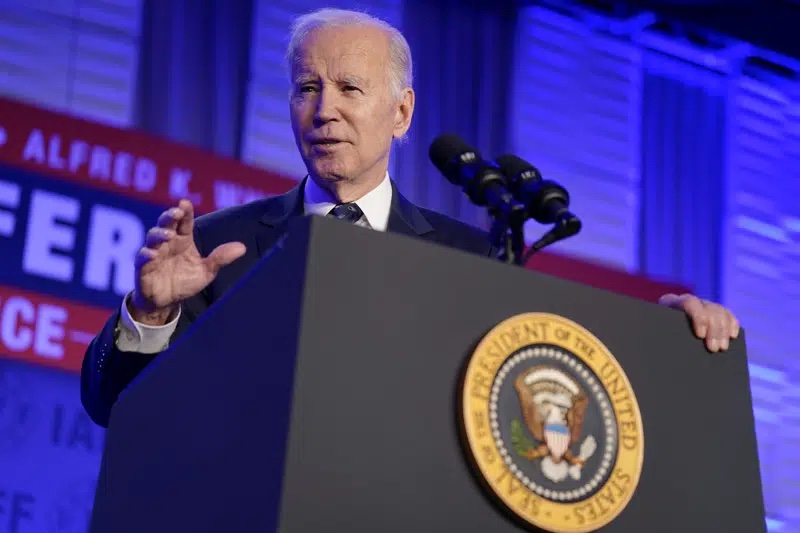President Biden’s proposed budget has set the stage for a political showdown between Democrats and Republicans in the lead-up to the 2024 Presidential elections. The budget includes ambitious spending plans, such as repealing Trump’s tax cuts for the wealthy, increasing corporate tax rates to fund Medicaid and Medicare, and other programs focusing on the environment, education, and deficit reduction. However, the Republicans may attack the future of Social Security, as it was not addressed in the budget.
During an Ethnic Media Services (EMS) briefing, Chad Stone, Chief Economist at the Center for Budget and Policy Priorities, Elizabeth Lower-Basch, Deputy Executive Director of Policy at the Center for Law and Social Poverty CLASP, and Andrew Eschtruth, Associate Director for External Relations at the Center for Retirement Research at Boston College shared their insights on the budget.
According to Chad Stone, while President Biden’s budget proposal represents his vision and desires, the Constitution grants Congress the power of the purse regarding taxes and spending, so Congress has no obligation to accept the President’s proposals. With a Democratic-controlled Senate, a budget reflecting this vision is likely to pass, but it won’t be a rubber stamp for the President.
The Republican-controlled House may propose its own budget, but their rhetoric does not even honor the rules of arithmetic. Their reckless and dangerous brinkmanship over the debt limit could blow up everything. The President’s proposed budget invests in children, supports workers, and promotes housing affordability, education, and core government functions, among other things. It also broadens opportunities for people and communities that have been under-invested, such as people with low incomes, people of color, indigenous communities, and people in rural communities.
The budget proposes raising taxes on high-income individuals and profitable corporations that have benefited the most from the nation’s economy. It also includes a multitude of programs that are financed by annual appropriations that Congress must vote on every year, rather than being financed by dedicated taxes like Social Security and Medicare. This includes non-defense discretionary spending, which funds programs that help people and communities, including Social Security and IRS administrative costs.
It is unclear how the budget will play out in the House, as there is a lot of uninformed or arithmetically impossible rhetoric at this point. It is possible that there won’t even be a budget process, and we live in interesting times.
Elizabeth Lower-Basch, Deputy Executive Director of Policy at the Center for Law and Social Poverty CLASP, discusses the safety nets proposed in the budget, emphasizing the importance of investments in children, families, seniors, and workers with low and moderate incomes. As pandemic programs wind down, families are struggling to cover the rising costs of food, child care, and health care. The President’s budget proposes reinstating the enhanced child tax credit and closing the coverage gap in Medicaid for people without children and low-income parents. The budget also includes $150 billion over 10 years to support seniors and people with disabilities receiving care at home or in community settings, rather than nursing homes.
Additionally, the budget prioritizes federal nutrition and food security programs, including school meals, the Women, Infants, and Children (WIC) program, and the Supplemental Nutrition Assistance Program (SNAP). It also proposes a national paid Family and Medical Leave program and a $600 billion investment over ten years in affordable child care, which would benefit 16 million children and provide pre-kindergarten for four million four-year-olds.
In response to a question about public health emergency spending, Elizabeth notes that the President’s budget proposes to close the Medicaid coverage gap in states that have not expanded and make permanent improvements to the Affordable Care Act. However, concerns have been raised about the complexity and potential gaps in coverage caused by the renewal process for Medicaid. While the administration is urging states to be diligent in outreach efforts, experts remain apprehensive about the potential fallout from the reapplication requirements. This highlights the need for a streamlined healthcare system that reduces paperwork and improves access to care.
In regards to Social Security, Andrew Eschtruth, Associate Director for External Relations at the Center for Retirement Research at Boston College, notes that while the budget did not provide many details on the matter, it did prioritize administrative spending for the program, which is crucial given the backlogs caused by office closures during the pandemic. However, the long-term financing shortfall of the program remains an issue, and discussions on ways to address it continue.
According to the Social Security program’s actuaries, if no policy changes are made, the program could pay full benefits until 2035, after which it could pay approximately 80% of benefits based on incoming payroll taxes. This has led to discussions on how to reduce or eliminate the shortfall, with options being to increase revenues, reduce benefits, or raise the full retirement age. However, the president’s budget did not propose any benefit reductions and instead aims to work with Congress to strengthen Social Security by ensuring that high-income workers pay more.
It is important to note that Social Security is the backbone of the US retirement and disability income systems, providing benefits to over 65 million people. Therefore, any changes to the program must be considered in the context of the whole retirement system, as many people lack access to employer-sponsored savings plans or traditional pensions.
#budget #governmentspending #federalbudget #socialsecurity #medicaid #nutritionprograms #childcare #familyleave #healthcare #pandemicresponse #economicrecovery #policy #politics









